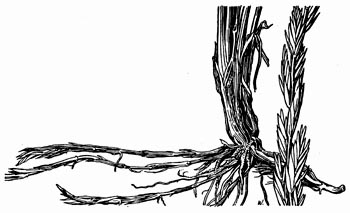Thickspike Wheatgrass

Common Name(s):
Thickspike Wheatgrass
Northern Wheatgrass
Streambank Wheatgrass
Scientific Name:
Elymus lanceolatus (Scribn. & Sm.) Gould
Scientific Name Synonyms:
Agropyron dasystachyum (Hook.) Scribn.
Elytrigia dasystachya (Hook.) A. & D. Love
Symbol:
ELLA3
Description:
Life Span: Perennial
Origin: Native
Season: Cool
Growth Characteristics: Thickspike wheatgrass is a long-lived, sod-forming grass that reproduces from rhizomes and by seed. Its stems are erect, smooth and 12–50 inches tall. It flowers from June through August
Seedhead: Its seedhead is a terminal, narrow, spike 1-9 inches tall. The spikelets are closely overlapped except sometimes near the base of the spike. Individual spikelets are 3/8 - 5/8 inch long and have 4-8 florets that are solitary at each node or occasionally in pairs. The glumes are lancelike, often sharp to awn-pointed and smooth to slightly hairy. Lemmas are hairy and awnless or awn-pointed.
Leaves: Leaf blades are narrow, 1/16-1/8 inch wide, 2-10 inches long, and generally flat or rolled. The ligule is short, collar-shaped, and membranous. The auricles are small and slender.
Growth Characteristics:
Ecological Adaptions:
Thickspike wheatgrass is found at elevation from 4,000-11,000 feet, where annual precipitation if 8-20 inches. It is found on dry hillsides, exposed flat ridges, well-drained meadows, along roadsides and other disturbed sites. It can withstand moderate flooding, but will not tolerate long periods of inundation, poorly drained soils, or excessive irrigation. It is drought, grazing, fire, and cold tolerant, but is not shade tolerant. Its relatively low nutrient requirements allow it to establish on mine spoils, depleted rangelands, and other disturbed areas.
Soils: Found on dry, medium to coarse textured soils in open areas. It can tolerate high pH conditions.
Associated Species: Big sagebrush, rabbitbrush, western wheatgrass, blue grama globemallow, and Sandberg bluegrass.
Uses and Management:
Thickspike wheatgrass’s low stature and fine herbage make it a good source of forage for cattle, horses and deer. It is preferred by livestock mid-spring or early summer. It is well adapted to control erosion and to promote water infiltration in the upland sagebrush-grassland sites. It recovers well from spring and fall grazing and can withstand heavy grazing, although managing a site for moderate grazing will encourage it to spread and become thicker.
Thickspike wheatgrass is valued more for special purpose applications than for production as forage. The Bureau of Land Management (BLM) has identified the plant as a high-priority species for restoration of rangelands in the Great Basin. It is commonly used in revegetation of oil and gas well sites, pipeline construction areas, roadsides, and other construction sites that will receive little or no maintenance. It is a good revegetation species because it forms tight sod under dry rangeland conditions, has good seedling strength, and performs well in low fertility or eroded sites. Numerous cultivars of thickspike wheatgrass are commercially available, including 'Bannock,' 'Critana,' 'Elbee,' 'Schwendimar,' 'Secar,' and 'Sodar'.
Thickspike wheatgrass is often used in urban areas, where irrigation water is limited, to provide ground cover and stabilize ditch banks, dikes, and roadsides.
Though thickspike wheatgrass does not compete well with aggressive, introduced grasses while it is establishing, it is quite compatible with native species that develop more slowly, such as bluebunch wheatgrass, western wheatgrass, and needlegrass (Stipa spp.) species. It performs especially well in bluebunch wheatgrass, ponderosa pine (Pinus ponderosa), and Douglas-fir roadside habitats.
Thickspike wheatgrass's sod-forming ability, which allows it to crowd out weeds and resist brush invasion, makes it especially desirable for long-term weed management. Studies have reported that thickspike wheatgrass, including its cultivars, is effective at controlling Russian knapweed (Acroptilon repens) and diffuse knapweed (Centaurea diffusa). Thickspike wheatgrass is susceptible to damage by the Russian wheat aphid and, according to a Utah study, may be even more susceptible after spring grazing. Grasshoppers may thin thickspike wheatgrass stands.

